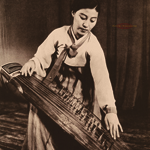|
|
 |
Dusted Reviews
Artist: V/A Album: Scattered Melodies: Korean Kayagum Sanjo Label: Sublime Frequencies Review date: Feb. 5, 2013 |

|
|
|
 |
When Robert Millis, the compiler of Scattered Melodies, first heard Korean Sanjo music, he likened it to 20th century composers like Shostakovich and Scelsi, as well as Sun City Girls. I hear something quite different: Delta blues. Maybe it’s just a quirk of the medium from which this record was sourced. Millis found all 13 tracks, which were performed by five different kayagum players over about 30 years, on 78rpm records. Music pried from crackly shellac projects immediacy and remoteness in a way that you can’t get via any other medium, probably because the performance was recorded live by physical processes in a room, while the surface noise makes palpable the passage of time. Mastering engineer Timothy Stollenwerk’s decision to leave much of that noise untouched only amplifies the album’s sense of something once living being transmitted across a temporal gulf.
But I think it also has to do with an expressive device prized by both slide guitarists and kayagum players. The kayagum is a zither, roughly five feet long and one foot wide, which is played with one end propped on the knee and the other on the ground, like so. In other words, it’s a bit like an overgrown lap steel guitar, and just as well suited to playing long swooping flourishes, voluptuous vibratos and microtonal accents. Heard through a flurry of surface noise, it’s hard not to think of Blind Willie Johnson.
But to think of Blind Willie, there has to be something else present, and that’s a life force that death and time can’t vanquish. Sanjo evolved around 1890, and the word literally translates as “scattered melodies.” It draws on older Korean music, but it’s improvised, with the kayagum player mixing up and revising the old tunes. This stuff bursts with invention and focused excitement. Listen to how Jung Nam Hee builds velocity whilst twisting the melody on “Chajinmori”; he’s in the zone, airborne but in control, and it’s a thrill to hear how he flies through the piece. On each of these performances, unidentified players interject sparse accents, some shouted, some obtained by striking an hourglass-shaped changgo drum. The drumming doesn’t move the music so much as ratchet up its tension.
I have no idea if I’m experiencing what this music meant to the people who made it. According to the liner notes, when sanjo first appeared, elder musicians dismissed it as flashy and discombobulated. And Millis himself makes no pretense to this being any sort of definitive anthology. It’s just the 78s he was able to find. But music that defies death and time is a gift wherever it comes from, and this LP feels like just such a gift.
By Bill Meyer
|







